Study on Spatial and Temporal Characteristics and Influencing Factors of Carbon Emissions in the Urban Agglomeration of the Middle Reaches of the Yangtze River
Abstract
:1. Introduction
2. Materials and Methods
2.1. Study Area Overview and Data Processing
2.2. Research Methods
2.2.1. Global Spatial Autocorrelation Analysis
2.2.2. Geodetector
- (1)
- It can explore both quantitative and qualitative data.
- (2)
- It can detect the interaction between two factors on the dependent variable [39].
2.2.3. Geographically Weighted Regression Model
- In terms of analysis results, the global regression model can only obtain the overall status of the entire study area and may ignore the relationships between variables. The GWR model introduces the spatial geographic location of the data in the model, which can reflect the specific situation of the distribution of the relationships between variables in different geographic spaces.
- In terms of visualisation, GWR can use ArcGIS to present the numerical values of various parameters on the map, making it easier to study the changes in parameters as the spatial geographic relationship changes.
3. Results
3.1. Spatiotemporal Characteristics of Carbon Emissions
3.2. Global Spatial Autocorrelation
3.3. The Result of Geodetector
- (1)
- Single-factor detection results (Table 3).
- (2)
- Interaction factor detection results (Figure 3).
3.4. Geographically Weighted Regression Model
3.4.1. The Impact of Population on Carbon Emissions
3.4.2. The Impact of GDP per Capita on Carbon Emissions
3.4.3. The Impact of Energy Intensity on Carbon Emissions
4. Conclusions
- (1)
- In terms of total carbon emissions, the total carbon emissions of the middle reaches of the Yangtze River urban agglomeration show fluctuations between 2010 and 2020, the carbon emission reduction effect is unstable, and there is still room for more carbon emission reduction.
- (2)
- In terms of the spatial and temporal distribution of carbon emissions, those in the middle reaches of the Yangtze River urban agglomeration show obvious spatial variability, but the high carbon emission area is always concentrated in Wuhan and this remains unchanged.
- (3)
- In terms of the spatial distribution of factors influencing carbon emissions in the middle reaches of the Yangtze River urban agglomeration, in 2010, 2014, and 2017, population size was the most important factor influencing carbon emission divergence, and in terms of interaction, the interaction between energy intensity, GDP, and urbanisation was the cause of increasing carbon emissions. The impact of population size on carbon emissions has decreased from north to south, and the impact of energy intensity on carbon emissions has shown a spread from the most influential region from in the northwest to the centre and then to the northeast, while the GDP per capita has had little impact on the differences in the spatial distribution of carbon emissions.
- (4)
- In terms of the explanatory power of the factors influencing carbon emissions in the middle reaches of the Yangtze River urban agglomeration, given that the impact of population size on carbon emissions is weakening and will no longer be an important factor related to carbon emissions by 2020, and that the interaction between energy intensity, population size, urbanisation, and GDP capita gdp is the cause of increasing carbon emissions, carbon reduction strategies should focus on controlling energy intensity, and policies should be tailored to local conditions based on spatial differences in the degree of influence of different factors on carbon emissions.
5. Recommendations and Prospects
- (1)
- Strengthen technological innovation and improve energy use efficiency. The interaction between energy intensity and the level of economic development and urbanisation is the main driver of carbon emissions in the middle reaches of the Yangtze River urban agglomeration. The key factor influencing energy intensity is the development in the level of technology. The impact of energy intensity in the middle reaches of the Yangtze River urban agglomeration shows a distribution of high in the north and low in the south, and the high values are slowly shifting from the northwest to the northeast. this indicates that in the carbon emission control of the middle reaches of the Yangtze River urban agglomeration, the adjustment for Hubei cities should be prioritised more in the region, i.e., strengthening the technological innovation of Hubei cities and improving energy use efficiency, while allowing for more high-precision industries from the east coast to the central part, especially regarding the cities in the middle reaches of the Yangtze River cities in the northern part of the Yangtze River urban agglomeration.
- (2)
- Promote new urbanisation and build a green development city. This study also found that the urbanisation rate has been the main driver of carbon emissions in the middle reaches of the Yangtze River urban agglomeration since 2017 and 2020. Therefore, how to promote the intensive development of urban agglomeration and promote urban-rural integration and realise the promotion and popularisation of new green urbanisation in the middle reaches of the Yangtze River urban agglomeration in the process of urbanisation, are priority issues.
- (3)
- Based on resource endowment, optimise energy structure. The six high-energy-consuming industries in the middle reaches of the Yangtze River urban agglomeration account for a high proportion of industry and have still been on the rise in recent years. The consumption of fossil energy still accounts for a large proportion of the energy structure, and to achieve the goal of carbon peaking and carbon neutrality, it is necessary to adopt a variety of clean energy sources such as solar, wind, and geothermal energy according to local conditions. For example, Hubei province is not in a good position for photovoltaics; thus, the advantages of hydropower should be fully exploited, and wind power arrangements should be strengthened to adjust its energy structure. The economy of the Jiangxi province relies heavily on high carbon emission industries and it is difficult to adjust the industrial structure in the short term; thus, it should promote the conversion of coal to gas and coal to electricity and develop clean coal power where appropriate.
Author Contributions
Funding
Institutional Review Board Statement
Informed Consent Statement
Data Availability Statement
Conflicts of Interest
References
- Deng, R.; Li, Y. Measurement of carbon emission transfer in the process of undertaking domestic industrial transfer in central China. Ind. Econ. Rev. 2019, 18, 114–133. [Google Scholar]
- Zheng, X. Research on the construction and measurement of carbon emission accounting system for express delivery industry. Logist. Eng. Manag. 2018, 40, 103–104. [Google Scholar]
- Fang, C.; Zhang, G.; Xue, D. High-quality development of Chinese urban agglomerations and construction of science and technology collaborative innovation community. J. Geogr. 2021, 76, 2898–2908. [Google Scholar]
- Fang, C.; Ren, Y. Analysis of energy metabolic efficiency and environmental pressure of near- and long-range coupling between urbanization and ecological environment in the Beijing-Tianjin-Hebei urban agglomeration region. China Sci. Earth Sci. 2017, 47, 833–846. [Google Scholar]
- Fang, C.; Liang, L.; Wang, Z. Quantitative simulation and verification of the sustainable climbing law of the Beijing-Tianjin-Hebei urban agglomeration. China Sci. Earth Sci. 2020, 50, 104–121. [Google Scholar]
- Fang, C. The theoretical basis and regularity analysis of the synergistic development of Beijing-Tianjin-Hebei urban agglomeration. Adv. Geogr. Sci. 2017, 36, 15–24. [Google Scholar]
- Wei, X. Analysis of Land Use Carbon Emission Characteristics and Influencing Factors in Beijing-Tianjin-Hebei Region. Ph.D. Thesis, Xi’an University of Science and Technology, Xi’an, China, 2019. [Google Scholar]
- Wu, N.; Shen, R.; Zhong, S. Spatial and temporal patterns of carbon emissions from energy consumption in Jin, Shaanxi and Mongolia based on nighttime lighting data. J. Geoinf. Sci. 2019, 21, 1040–1050. [Google Scholar]
- Zhang, Y. Analysis of Global Regional Carbon Emission Influencing Factors Based on STIRPAT Model. Ph.D. Thesis, Northeast University of Finance and Economics, Dalian, China, 2021. [Google Scholar]
- Cheng, Y.; Zhang, Y.; Wang, J. Spatial and temporal evolution of China’s provincial carbon emission performance and technological innovation drivers. Geoscience 2023, 10, 1–11. [Google Scholar]
- Li, Z.; Ren, L.; Ma, R. Spatial and temporal patterns and drivers of carbon emissions in Zhejiang Province based on spatial and temporal geographically weighted regression models. J. Ningbo Univ. (Sci. Technol. Ed.) 2021, 34, 105–113. [Google Scholar]
- Xue, Y.; Xie, J.; Huai, C. Decomposition analysis of factors influencing energy carbon emissions in Beijing. Build. Energy Effic. 2022, 50, 128–132, (In Chinese and English). [Google Scholar]
- Zhou, A.; Wu, K. Analysis of the drivers of transportation carbon emissions in Shanghai. J. Hefei Univ. Technol. (Nat. Sci. Ed.) 2020, 43, 264–269. [Google Scholar]
- Cao, Z.; Zhang, X.; Zhan, X. Spatial and temporal variation of carbon emissions in counties of Shaanxi Province based on land use change and influencing factors. Soil Water Conserv. Bull. 2022, 42, 376–385. [Google Scholar]
- Liu, H.; Shao, M.; Ji, Y. Spatial pattern and dynamic evolution of carbon emissions in China: An empirical study based on county-level carbon emissions data. Geoscience 2021, 41, 1917–1924. [Google Scholar]
- Huong, T.T.; Shah, I.H.; Park, H.S. Decarbonization of Vietnam’s economy: Decomposing the drivers for a low-carbon growth. Environ. Sci. Pollut. Res. 2021, 28, 518–529. [Google Scholar] [CrossRef]
- Karakaya, E.; Bostan, A.; Özçağ, M. Decomposition and decoupling analysis of energy-related carbon emissions in Turkey. Environ. Sci. Pollut. Res. 2019, 26, 32080–32091. [Google Scholar] [CrossRef]
- Ang, B.W. LMDI decomposition approach: A guide for implementation. Energy Policy 2015, 86, 233–238. [Google Scholar] [CrossRef]
- Chen, F.; Zhang, J.; Ren, J. Spatial and temporal differences in carbon emissions in the Yellow River basin and the influencing factors based on LMDI model. J. Earth Environ. 2022, 13, 418–427. [Google Scholar]
- Zhou, Y.; Xu, Y.; Wang, X. Analysis of the change of industrial carbon emissions in Xinjiang and its influencing factors based on LMDI decomposition method. J. Xinjiang Norm. Univ. (Nat. Sci. Ed.) 2022, 41, 37–47. [Google Scholar]
- Ma, Y.; Shao, C. Analysis of factors influencing carbon emissions of energy consumption in the North-Shanghai-Tianjin region and study of decoupling effect based on LMDI. J. Gansu Sci. 2022, 34, 124–132. [Google Scholar]
- Li, J.; Huang, X.; Tui, X. Simulation of carbon emission scenarios in the Yangtze River Delta region under the background of “double carbon”. Ecol. Econ. 2022, 38, 13–18. [Google Scholar]
- Song, X.; Zhang, Y.; Wang, Y. Analysis of the impact of demographic factors on carbon emissions based on the IPAT extended model. Environ. Sci. Res. 2012, 25, 109–115. [Google Scholar]
- Wang, L.; Li, N.; He, J. Analysis of carbon emission influencing factors of transportation industry in Shaanxi Province based on STIRPAT model. Transp. Res. 2022, 8, 98–107. [Google Scholar]
- Behera, S.; Dash, D. The effect of urbanization, energy consumption, and foreign direct investment on the carbon dioxide emission in the SSEA (South and Southeast Asian) region. Renew. Sustain. Energy Rev. 2017, 70, 96–106. [Google Scholar] [CrossRef]
- Lv, Z.; Ling, D.; Chen, J. Study on the influence of energy eco-efficiency on carbon emission and spatial spillover effect–example of 110 cities in Yangtze River Economic Belt. J. Nanjing Univ. Technol. (Soc. Sci. Ed.) 2023, 22, 95–110+112. [Google Scholar]
- Liu, P.; Yuan, T.; Dong, H. Analysis of the spatial and temporal evolution of carbon emission intensity in “2+26” cities in Beijing, Tianjin, Hebei and surrounding areas and the influencing factors. Environ. Pollut. Prev. 2022, 44, 772–776+810. [Google Scholar]
- Wang, K.; Liu, Y.; Chang, G. Spatial spillover effects of tourism industry agglomeration on carbon emission efficiency of tourism. J. Ecol. 2022, 42, 3909–3918. [Google Scholar]
- Cheng, X.; Gai, W. Study on the spatial and temporal patterns of carbon emissions and influencing factors in five northwestern provinces. Environ. Sci. Technol. 2022, 45, 17–27. [Google Scholar]
- Yang, Q.; Peng, R.; Liu, X. A study on the influence of provincial carbon emissions based on geographical weighted regression. J. Environ. Eng. Technol. 2023, 13, 54–62. [Google Scholar]
- Wang, K.; Tang, S.; Gan, C. Spatial and temporal patterns of carbon emission intensity in China’s service sector and factors influencing it. China Popul.-Resour. Environ. 2021, 31, 23–31. [Google Scholar]
- Tian, J.; Zhang, J. Spatial and temporal distribution characteristics and drivers of carbon emissions in China based on geographic detectors. Ecol. Econ. 2022, 38, 13–20. [Google Scholar]
- Zhao, L.; Wu, D. Accounting for carbon emissions and spatial differentiation patterns on the energy supply side in China. China Popul.-Resour. Environ. 2018, 28, 48–58. [Google Scholar]
- Al-mulali, U. Factors affecting CO2 emission in the Middle East: A panel data analysis. Energy 2012, 44, 564–569. [Google Scholar] [CrossRef]
- Zeng, X.; Qiu, R.; Lin, D.; Hou, X.; Zhang, L.; Hu, X. Spatial and temporal heterogeneity of transportation carbon emissions and influencing factors in China. China Environ. Sci. 2020, 40, 4304–4313. [Google Scholar]
- Wang, X.; Zhou, B. Study on the influencing factors of carbon emission efficiency in BRICS countries. J. China Acad. Environ. Manag. Cadres 2018, 28, 55–58. [Google Scholar]
- Wang, Y.; Xie, L. Decomposition analysis of domestic carbon emission factors in Chinese cities and towns based on LMDI model and Q-type clustering. Environ. Sci. Res. 2019, 32, 539–546. [Google Scholar]
- Qi, H.; Shen, X.; Long, F. Spatial and temporal patterns and influencing factors of carbon emissions in Zhejiang counties. Yangtze River Basin Resour. Environ. 2023, 32, 821–831. [Google Scholar]
- Wang, J.; Xu, C. Geodetectors: Principles and perspectives. J. Geogr. 2017, 72, 116–134. [Google Scholar]
- Birdsall, N. Another Iook at Population and Global Warming Population, Health and Nutrition Policy Research; Working Paper, WPSl020; World Bank: Washington, DC, USA, 1992. [Google Scholar]
- Knapp, T.; Mookeriee, R.P. Growth and global CO2 Emissions. Energy Policy 1996, 24, 31–37. [Google Scholar] [CrossRef]
- Douglas, H.E.; Thomas, M.S. Stoking the fires? CO2 emissions and economic growth. J. Public Econ. 1995, 57, 85–101. [Google Scholar]
- Tian, L.; Zhang, B. Factor decomposition analysis of carbon emission changes in China. China Popul. Resour. Environ. 2011, 21, 1–7. [Google Scholar]
- Ang, B. Decomposition of industrial energy consumption: The energy intensity approach. Energy Econ. 1994, 16, 163–174. [Google Scholar] [CrossRef]
- Sahu, S.K.; Narayanan, K. Decomposition of industrial energy consumption in Indian manufacturing: The energy intensity approach. J. Environ. Manag. Tour. 2010, 1, 22–38. [Google Scholar]
- Zhu, C.; Ma, Z.; Wang, C.; Liu, Z. Analysis of the variance characteristics of CO2 emissions due to energy consumption in China. Ecol. Environ. 2006, 5, 1029–1034. [Google Scholar]
- Bi, X. Research on the mechanism of urbanization’s impact on carbon emissions. Shanghai Econ. Res. 2015, 325, 97–106. [Google Scholar]
- Hu, B.; Shao, J. The impact of FDI on China’s CO2 emissions—An empirical study based on spatial Durbin and multiple threshold models. J. Tianjin Univ. Commer. 2022, 42, 49–58. [Google Scholar]
- Wang, L. Foreign direct investment, economic growth and carbon dioxide emissions in China—An empirical study based on a biased linear additive panel model. Mod. Mark. (Low. J.) 2020, 8, 8–11. [Google Scholar]
- Rahman, M.M.; Alam, K. CO2 Emissions in Asia–Pacific Region: Do Energy Use, Economic Growth, Financial Development, and International Trade Have Detrimental Effects? Sustainability 2022, 14, 5420. [Google Scholar] [CrossRef]
- Wang, Q.; Song, X. Quantified impacts of international trade on the United States’ carbon intensity. Environ. Sci. Pollut. Res. Int. 2022, 29, 33075–33094. [Google Scholar] [CrossRef]
- Liu, X.; Gao, C.; Zhang, Y. Spatial heterogeneity of spatial dependence pattern of carbon intensity and its influencing factors in Chinese provinces. Geoscience 2018, 38, 681–690. [Google Scholar]
- Huang, R.; Wang, Z.; Ding, G. Influencing factors and trend prediction of carbon emissions from energy consumption in Jiangsu Province based on STIRPAT model. Geogr. Res. 2016, 35, 781–789. [Google Scholar]
- Du, L. Factors influencing carbon dioxide emissions in China: A study based on provincial panel data. South. Econ. 2010, 11, 20–33. [Google Scholar]
- Deng, G.; Chen, G. Characteristics of spatial and temporal distribution of carbon emissions from energy consumption and influencing factors in Lanxi urban agglomeration–based on DMSP/OLS and NPP/VIIRS nighttime lighting data. J. Xihua Univ. (Philos. Soc. Sci. Ed.) 2022, 41, 40–60. [Google Scholar]
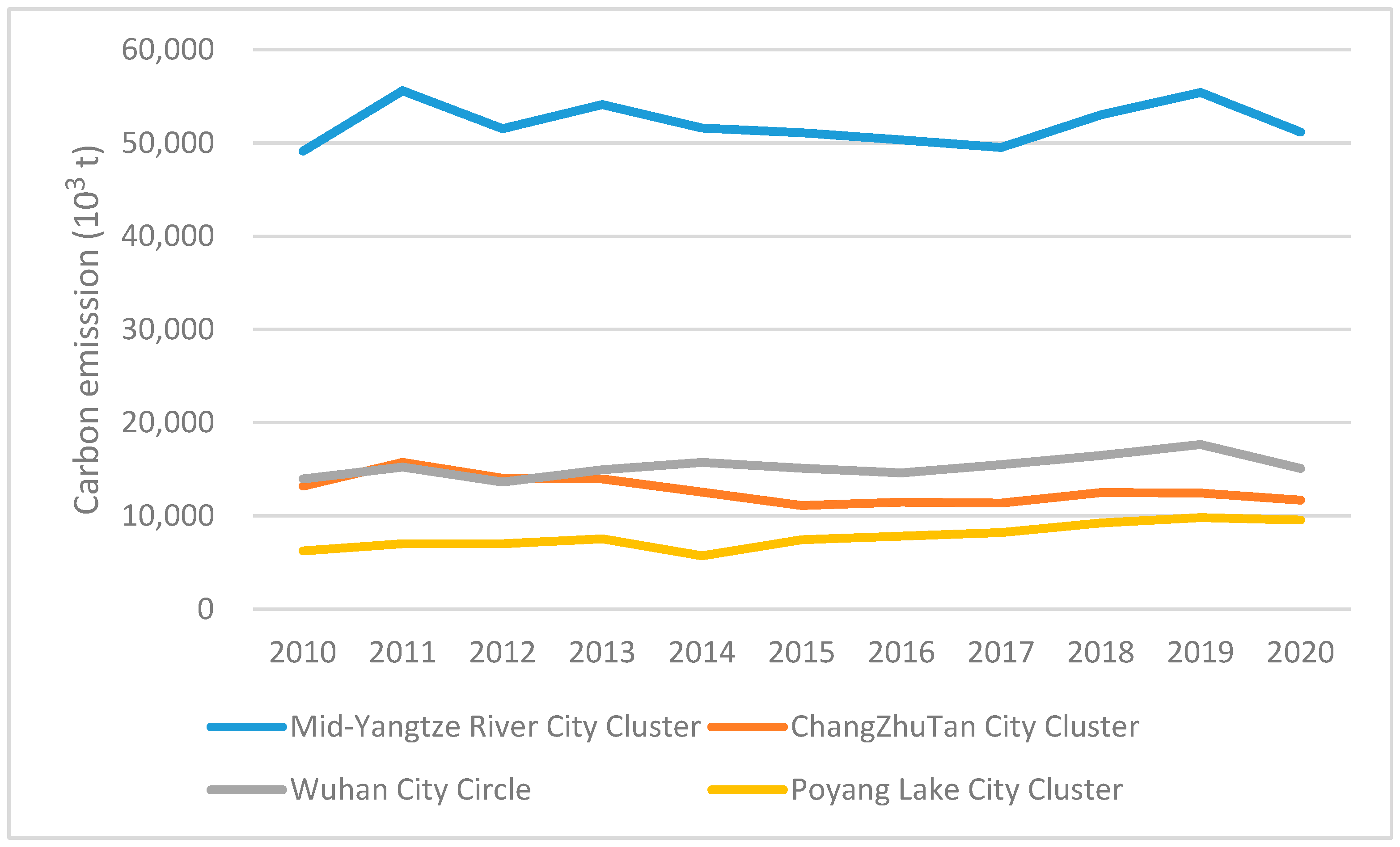
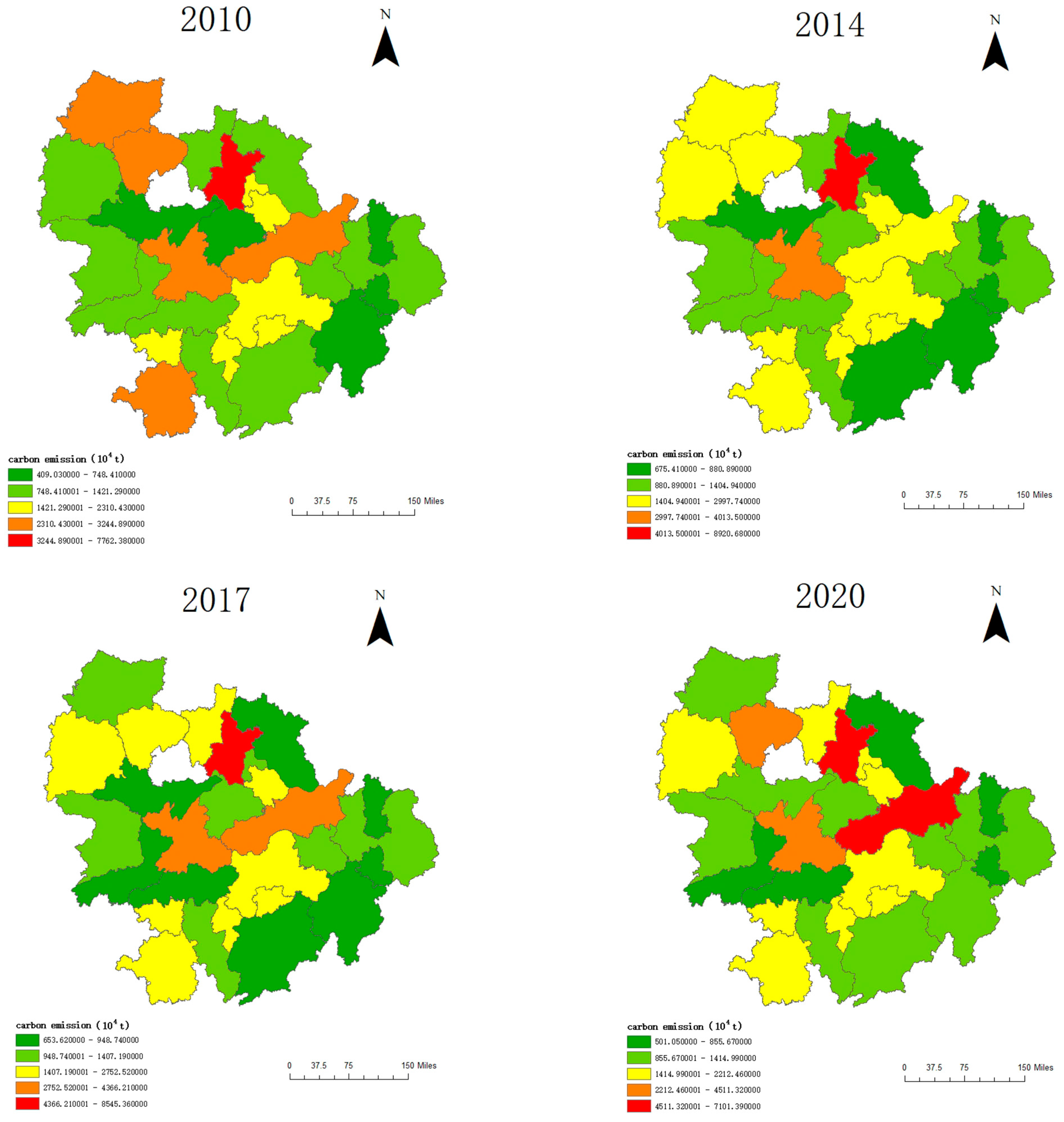
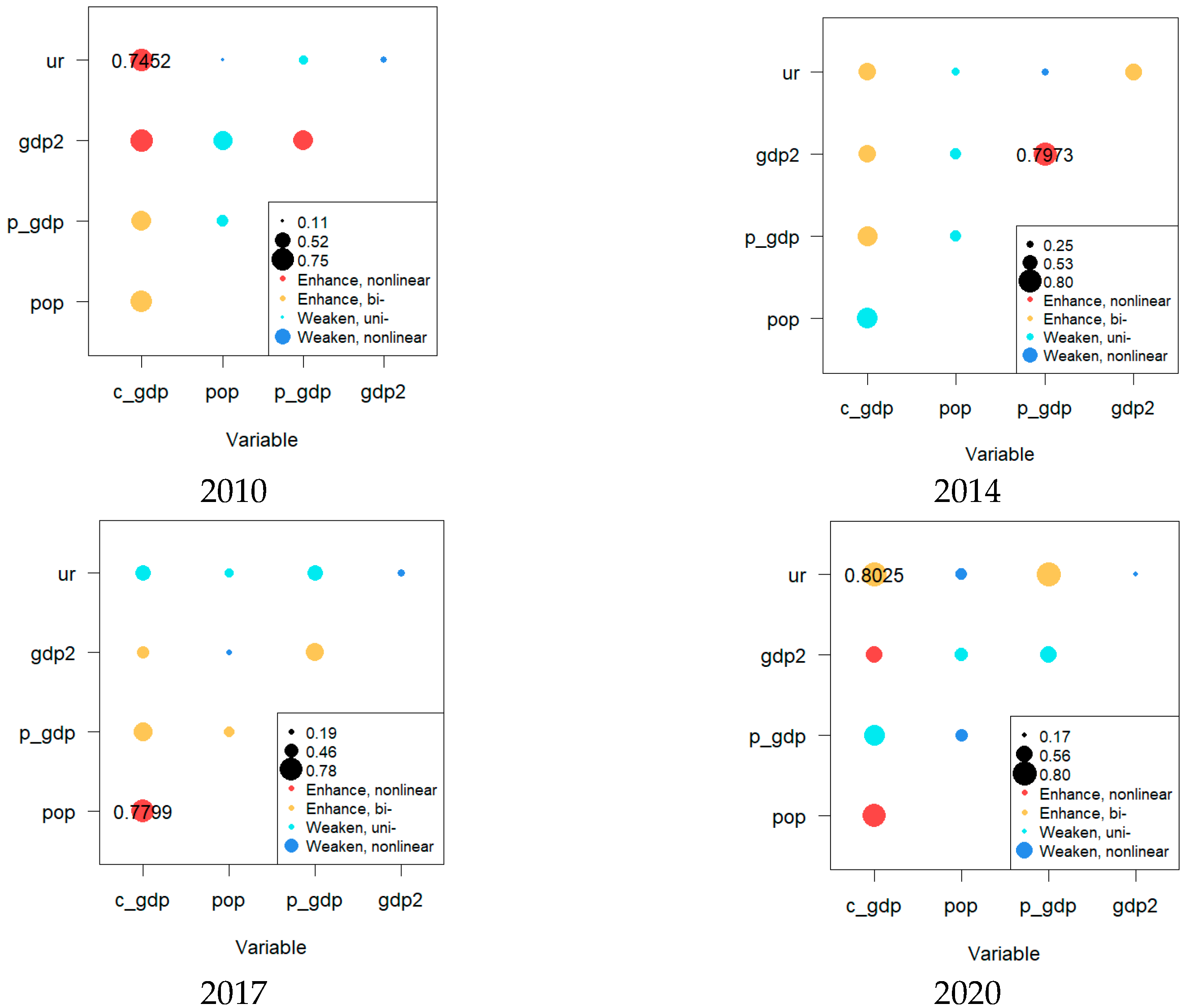
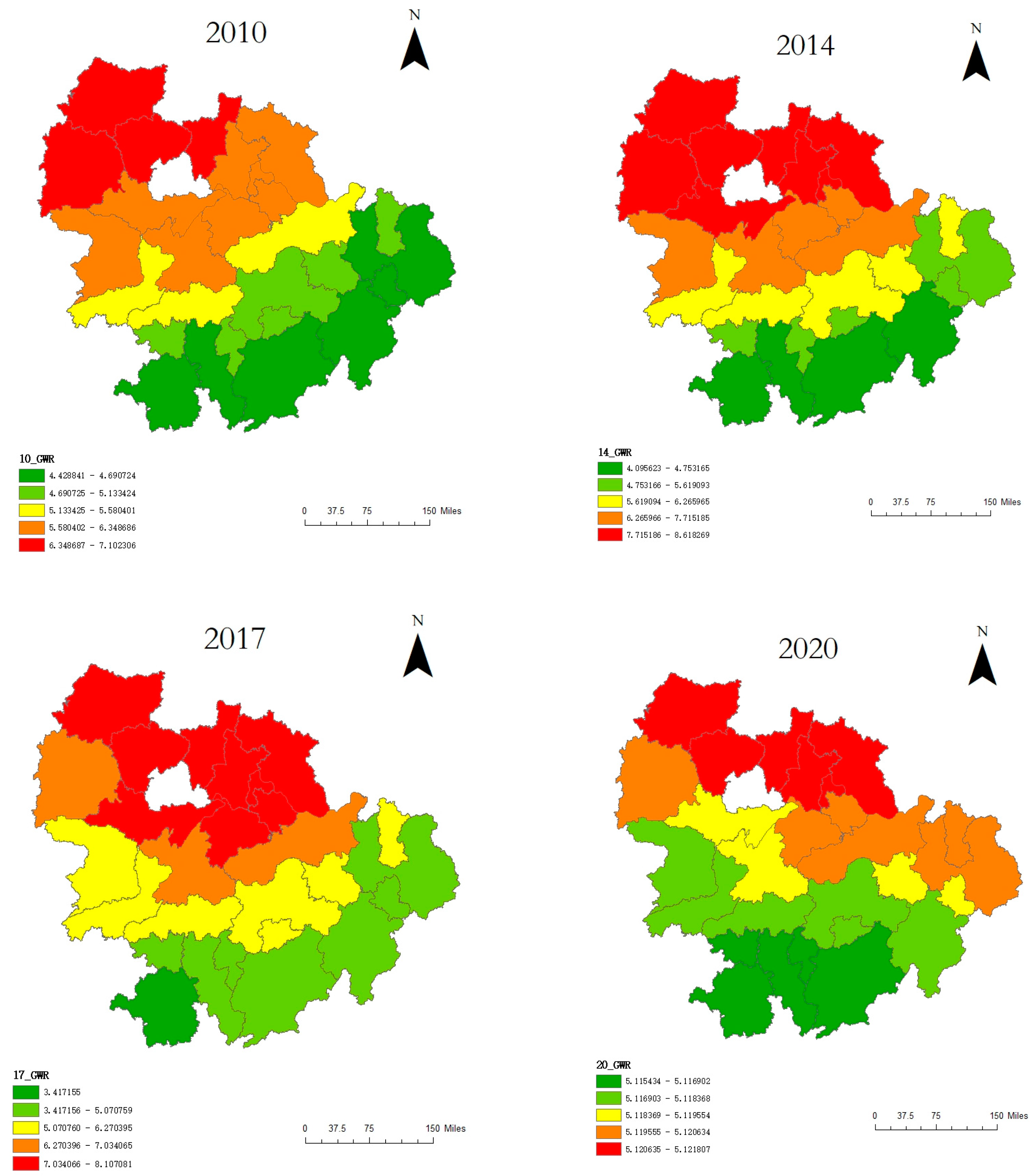
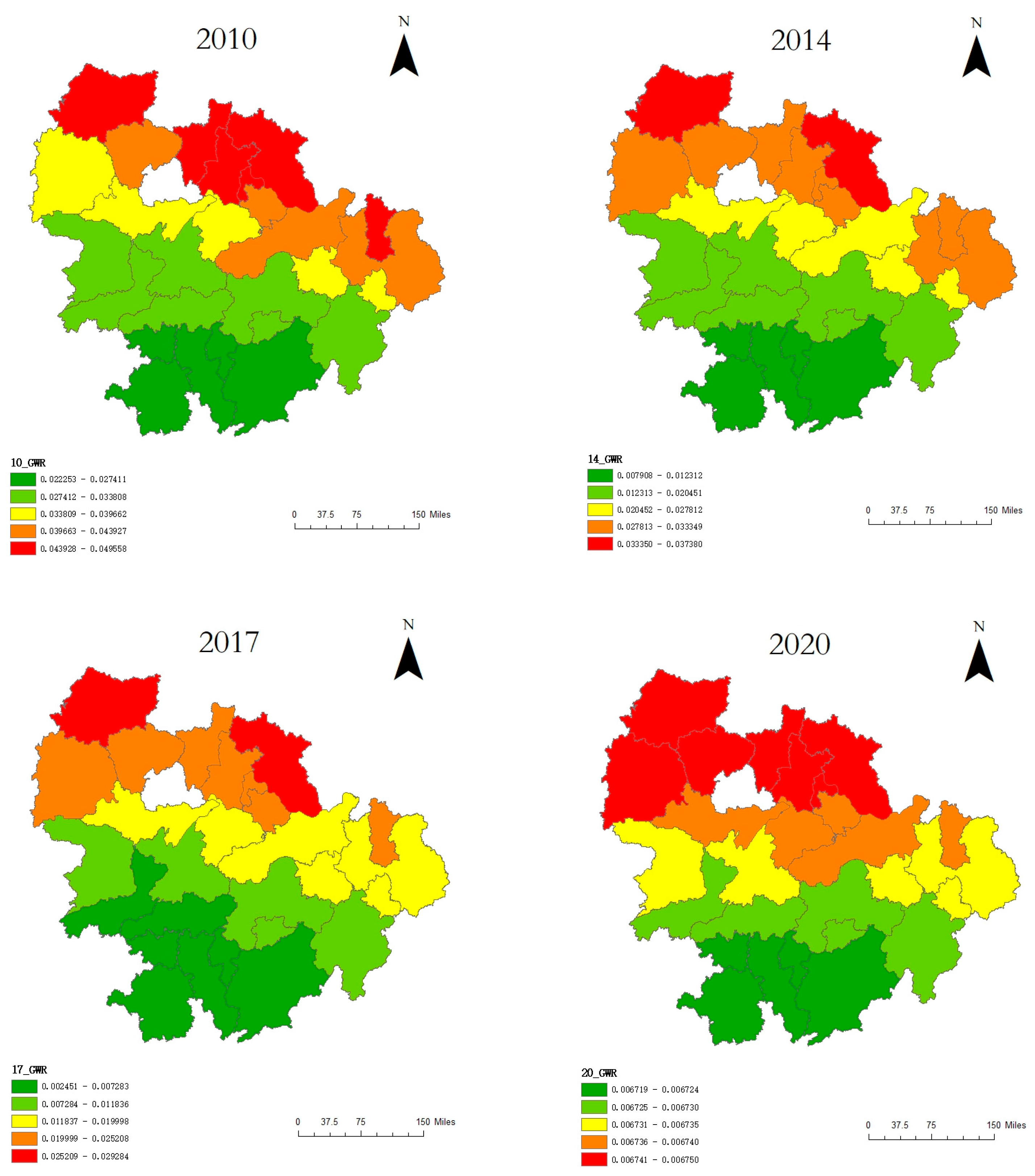
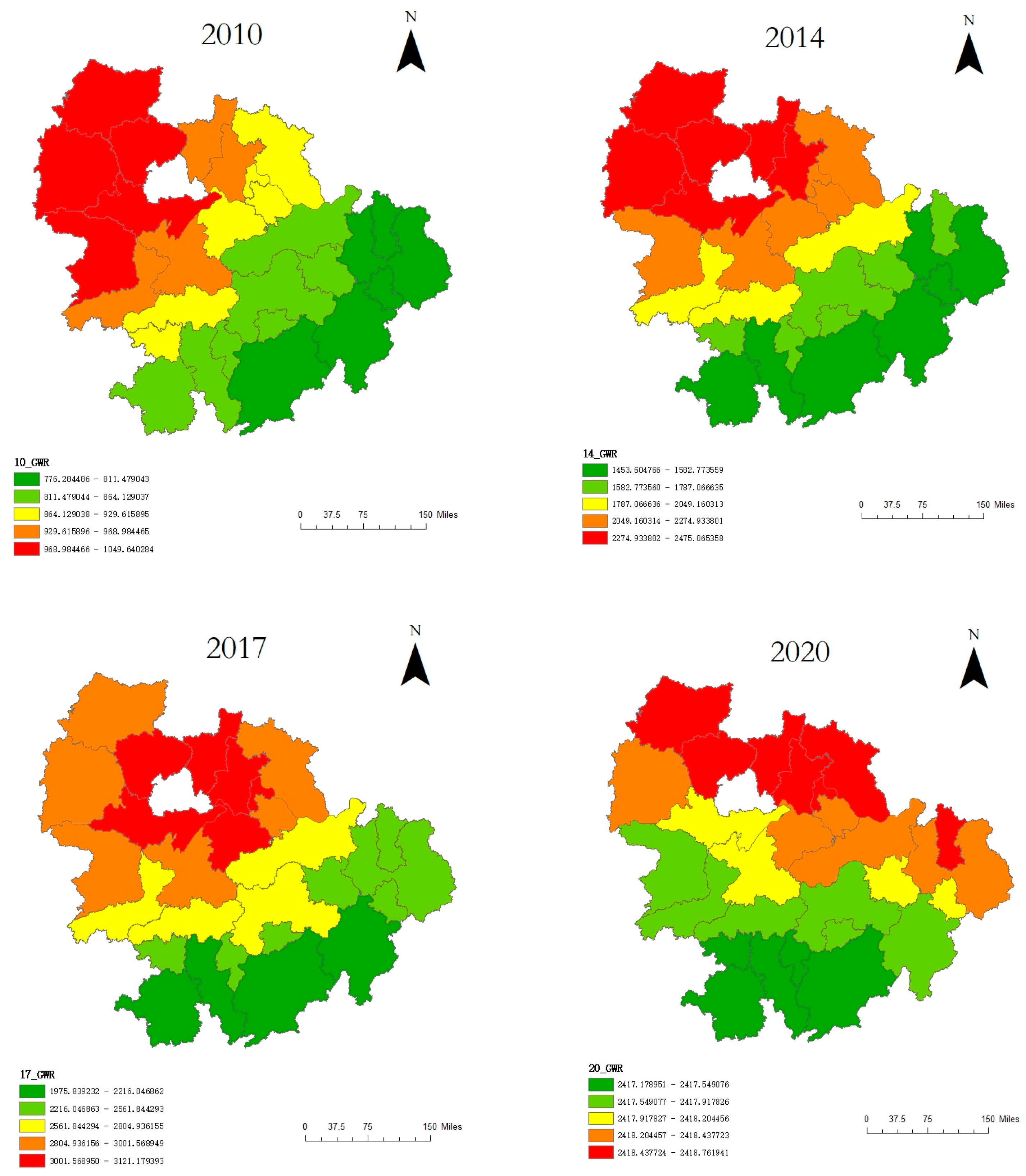
| Province | City |
|---|---|
| Hubei Province | Wuhan, Jingmen, Huanggang, Xianning, Yichang, Xiangyang, Ezhou, Huangshi, Xiaogan, Jingzhou |
| Hunan Province | Changsha, Yueyang, Changde, Zhuzhou, Xiangtan, Hengyang, Yiyang |
| Jiangxi Province | Nanchang, Jiujiang, Yichun, Fuzhou, Shangrao, Jingdezhen, Ji’an, Pingxiang, Yingtan |
| Variable | 2010 | 2011 | 2012 | 2013 | 2014 | 2015 | 2016 | 2017 | 2018 | 2019 | 2020 |
|---|---|---|---|---|---|---|---|---|---|---|---|
| Moran’I | −0.19 | −0.20 | −0.22 | −0.20 | −0.17 | −0.17 | −0.15 | −0.15 | −0.11 | −0.07 | −0.09 |
| Z-value | −1.63 | −1.70 | −1.82 | −1.73 | −1.55 | −1.39 | −1.14 | −1.17 | −0.71 | −0.33 | −0.52 |
| p-value | 0.10 | 0.09 | 0.07 | 0.084 | 0.12 | 0.16 | 0.26 | 0.242 | 0.48 | 0.74 | 0.61 |
| Impact Factor | q-Value | |||
|---|---|---|---|---|
| 2010 | 2014 | 2017 | 2020 | |
| Population size (pop) | 0.7012 | 0.7012 | 0.7013 | 0.4666 |
| GDP per capita (p_gdp) | 0.3777 | 0.3774 | 0.3610 | 0.7225 |
| Energy intensity (c_gdp) | 0.4019 | 0.4031 | 0.3112 | 0.2862 |
| Share of secondary sector (gdp2) | 0.2432 | 0.2431 | 0.3246 | 0.1727 |
| Urbanisation rate (ur) | 0.2430 | 0.2693 | 0.7408 | 0.7064 |
| 2010 | 2014 | 2017 | 2020 | ||||
|---|---|---|---|---|---|---|---|
| Interaction Factor | q | Interaction Factor | q | Interaction Factor | q | Interaction Factor | q |
| ur∩c_gdp | 0.7452 | pop∩c_gdp | 0.7087 | pop∩c_gdp | 0.7799 | ur∩c_gdp | 0.8025 |
| c_gdp∩gdp2 | 0.7400 | c_gdp∩p_gdp | 0.7024 | c_gdp∩p_gdp | 0.6490 | ur∩p_gdp | 0.7947 |
| pop∩c_gdp | 0.7215 | ur∩c_gdp | 0.7520 | p_gdp∩gdp2 | 0.6063 | pop∩c_gdp | 0.7688 |
| c_gdp∩p_gdp | 0.6737 | p_gdp∩gdp2 | 0.6624 | ur∩c_gdp | 0.5401 | c_gdp∩p_gdp | 0.6868 |
| p_gdp∩gdp2 | 0.6624 | ur∩c_gdp | 0.6121 | ur∩p_gdp | 0.5244 | p_gdp∩gdp2 | 0.5666 |
Disclaimer/Publisher’s Note: The statements, opinions and data contained in all publications are solely those of the individual author(s) and contributor(s) and not of MDPI and/or the editor(s). MDPI and/or the editor(s) disclaim responsibility for any injury to people or property resulting from any ideas, methods, instructions or products referred to in the content. |
© 2023 by the authors. Licensee MDPI, Basel, Switzerland. This article is an open access article distributed under the terms and conditions of the Creative Commons Attribution (CC BY) license (https://creativecommons.org/licenses/by/4.0/).
Share and Cite
Zhang, H.; Lei, Y. Study on Spatial and Temporal Characteristics and Influencing Factors of Carbon Emissions in the Urban Agglomeration of the Middle Reaches of the Yangtze River. Sustainability 2023, 15, 10176. https://doi.org/10.3390/su151310176
Zhang H, Lei Y. Study on Spatial and Temporal Characteristics and Influencing Factors of Carbon Emissions in the Urban Agglomeration of the Middle Reaches of the Yangtze River. Sustainability. 2023; 15(13):10176. https://doi.org/10.3390/su151310176
Chicago/Turabian StyleZhang, Huang, and Yidong Lei. 2023. "Study on Spatial and Temporal Characteristics and Influencing Factors of Carbon Emissions in the Urban Agglomeration of the Middle Reaches of the Yangtze River" Sustainability 15, no. 13: 10176. https://doi.org/10.3390/su151310176
APA StyleZhang, H., & Lei, Y. (2023). Study on Spatial and Temporal Characteristics and Influencing Factors of Carbon Emissions in the Urban Agglomeration of the Middle Reaches of the Yangtze River. Sustainability, 15(13), 10176. https://doi.org/10.3390/su151310176







